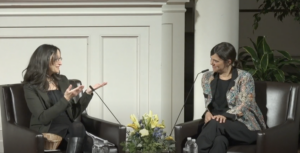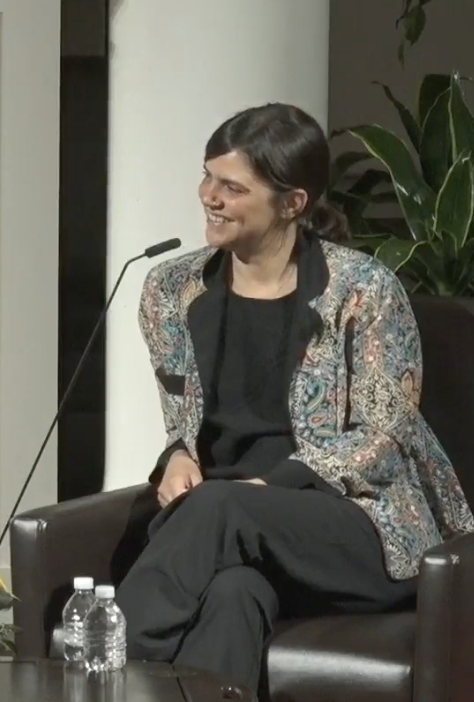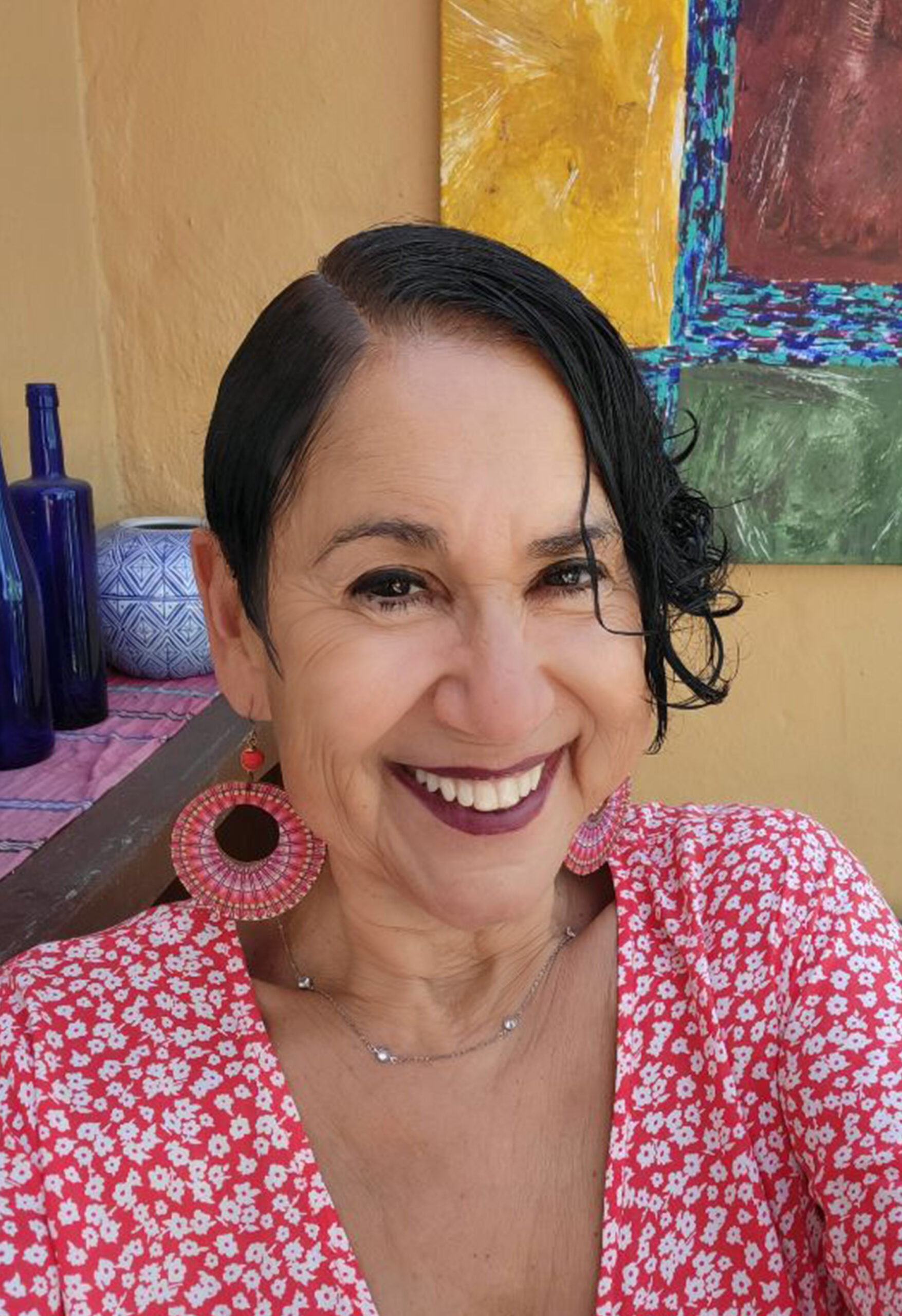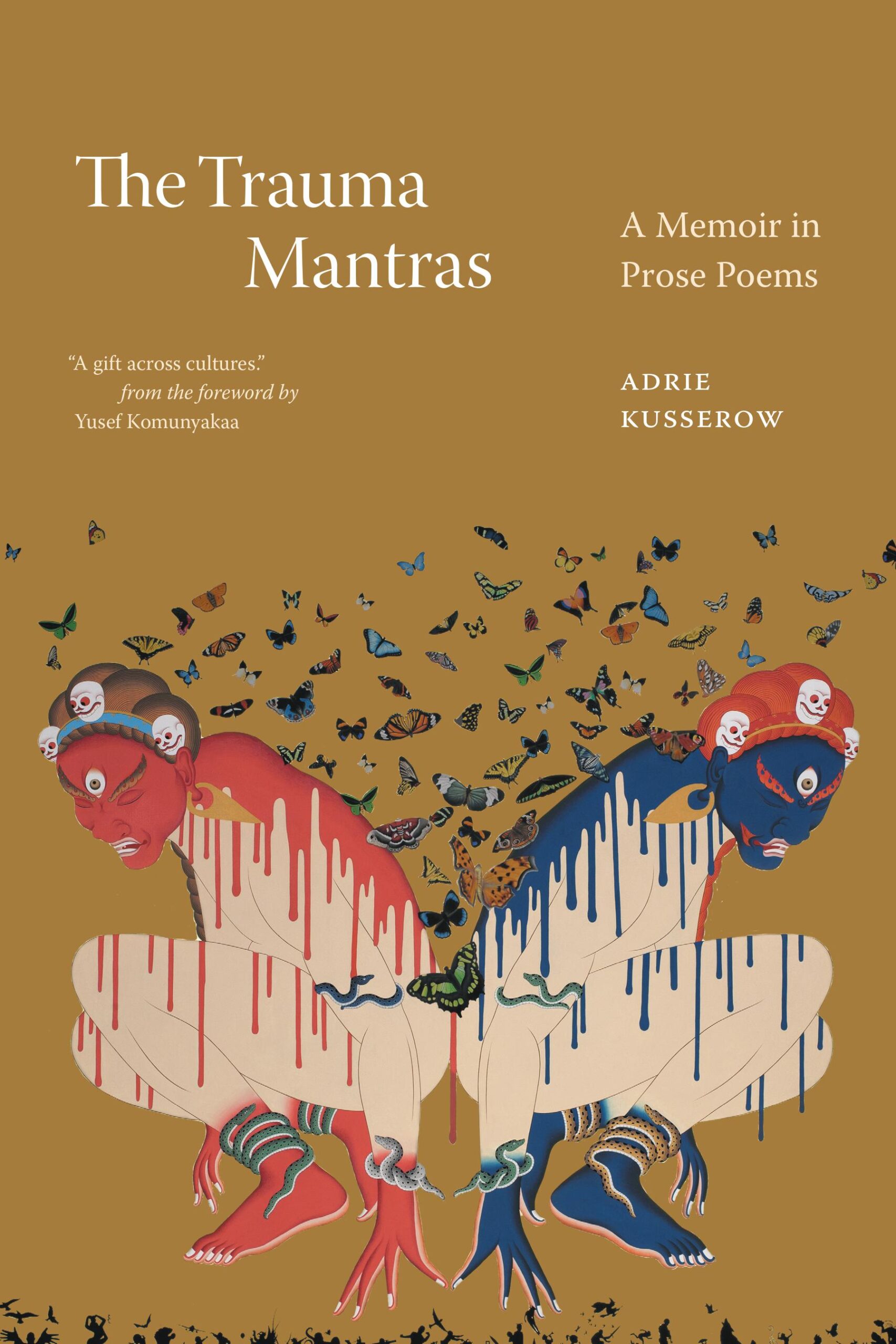
After thirty-six hours of travel, VALERIA LUISELLI arrived at Amherst College LitFest on a freezing Saturday night just in time to speak with The Common’s editor-in-chief JENNIFER ACKER. Their conversation explored the capacity of memory to shape geography, the relationship between language and home, and the architecture of a book. Luiselli also spoke with honesty and ardor about her research in and around the U.S.-Mexico borderlands and her experience as a legal translator for refugees, experiences informing her acclaimed novel Lost Children Archive. This interview is an edited and condensed version of the live conversation; read more about LitFest, and watch a video of the full conversation online.
Jennifer Acker (JA): I wanted to begin with a couple of questions about place. You grew up in many places, and your work is rooted in exploring places, both private and public. So I wanted to ask a personal question about how you use the word “home” yourself, and how your characters think about that word.
Valeria Luiselli (VL): This is a very difficult question to start with, but a very good question. I think it has always been through the process of writing a place that I am able to make myself at home in it; it’s only the places I’ve written about that feel somewhat deeply rooted in me.
So what do I call “home?” I’m a combination of beds, bathroom mirrors, hotel rooms, cities, all of which have come together in my imagination and formed some other literary space. Spaces like the U.S.-Mexico borderlands are more alive in me than cities where I’ve lived because I’ve spent so much time inside them.
JA: When you write about places, are there particular aspects of those places that you’re trying to capture? Are there research components as well as experiential components?
VL: It depends on what place I’m thinking about. For example, I recently wrote a long piece for Echoes from the Borderlands about a copper mine in Bisbee, Arizona, a town I had never been to until five or six years ago. It was through speaking to people about how they see the town—asking, for example, a miner to describe the open pit copper mine—that I was able to situate myself.
Years ago, I was writing a book about Mexico City, where I was born but had never really lived until then, and trying to root very deeply. I used to rent an apartment in the now very hip Colonia Roma. It was perpetually under construction; there was always noise of machinery and things being torn down. At the beginning, I thought, there’s no way I will ever be able to write a book in this complete lack of silence, so then I said, “instead of trying to encapsulate myself against the noise of the world, let me open the window—physically and metaphorically—and see what happens to my writing.” It was a very good choice because what was coming in the next years were children, even noisier places, and life getting more uncontainable. I would not have written anything, I think, if I had tried to write against the noise of everyday life.
JA: I want to ask you a little bit about the structure of your books, many of which are written in short sections that build on each other and accumulate. I wonder if that reflects how your mind works, only having short bursts of time to work in—like Alice Munro, who wrote short stories because she was raising small kids—or if this is a more theoretical approach.
VL: No, it’s not theoretical at all. I think it has to do with a combination of the two things you’ve just said: real life circumstances, like how many minutes of concentration I might get, and how my attention works.
I’ve made peace with the fact that I can concentrate very well on short fragments, and then I rework them as if they were a small sculpture—take them apart and put them back together. It doesn’t matter how many times I’ve done this, it’s always as if I haven’t learned how to do it. When I begin a new book, my question is, “how did I do this last time?” Then usually when I finish a book, the question is “how the hell did I do this?” I find an architecture inside of, or with, all this material.
JA: How did you do it in previous books? Let’s take Lost Children Archive. Do you remember how you found the throughline for that?
VL: With Lost Children Archive, one or two questions were guiding me very forcefully. What happens when you spend time enclosed—in the space of a car, for example—with children who are reenacting reality and reinterpreting story in a way that makes the adult world start to feel strange? I wanted to explore how a child’s imagination may take over a narrative completely, and, at the same time, what that meant in generational terms. What happens when you hand down a story to a generation and that generation reconfigures it? It wasn’t hard to put things together because a plot emerged from that momentum.
JA: In Lost Children Archive, there’s also a careful attention to absence and ghosts, as in some of your other work. There’s a keen observation of, or listening for, the absences of past lives, or the remnants of past lives that have made it into the present. I wonder where that concern comes from, and is that something that’s conscious?
VL: It’s conscious to a degree. I’ll give you a very concrete example with something I’ve been trying to work on for some time now. Three or four years ago, I was interviewing men who reenact scenes from the American western and southwestern mythology in a very successful town in Arizona called Tombstone and a smaller town in New Mexico called Shakespeare. It happens to be right at the border with my country—or, my other country—and the fact that it ignores Mexico so consistently has always made me wonder. There are no Mexican characters in the reenactments, even as enemies.
I’ve been doing all the archival research I’ve been able to do. There’s very little on Shakespeare, but there are, for example, fascinating censuses, full of Mexican inhabitants not present in any of the narratives of the town. It is in that process that I find something enticing for the imagination; let’s look at all the things that have been consistently ignored and let’s start from there. How did this person look? What was their job? Why did they end up in Shakespeare in New Mexico? My work is very rooted in space, yes, and history as well, but I’m not a historian, so I can happily depart from the archive and use it for fiction-making.
JA: You have spoken about beginning your writing career by writing in Spanish; Lost Children Archive was written in English. Can you tell us about that journey from writing in Spanish to writing in English, and maybe the stops and key moments along the way?
VL: I’ve become a traitor and I write in the language of the empire, so I’m fully colonized.
I started writing in Spanish because I really wanted to. I had been schooled in English and had a complicated relationship to it. It had been always a language in which I was scolded at school—and I was very often scolded at school—so it felt less like a playground and more like the language of hierarchy, so I started writing in Spanish. It was not all playground, but it was a kind of nostalgia for something not lived—something that I was born into. It felt like a recovery, and a coming back home.
The process of thinking “English or Spanish?” is a way I procrastinate for years, because I make notes in both and tell myself that eventually one note is going to be the beginning of the novel. Sometimes it’s three years, or four, before I hit that note and start actually writing. That happened with Lost Children Archive. I wrote it in both languages and notebooks until something happened in English. I said, “This is it. I have to follow this voice, this tone.”
JA: Tell Me How It Ends and Lost Children Archive are sort of companion books; one is a novel, one is an essay, both are concerned with undocumented children coming from Mexico or Central America to the U.S. Can you say a little about how that focus of undocumented children came into your life in such a way that you wanted it to be the subject of your writing?
VL: I grew up in South Africa in the mid-1990s at the beginning of the democratic era, the fall of the apartheid regime and the presidency of Mandela, and I wanted to write a somewhat biographical piece about what it meant to be a child going through a transition of that kind in a country. Then the so-called immigration crisis—I say so-called because it is more accurately called a refugee crisis—started in the summer of 2014. I was crossing the United States by car with my family, and I could not wrap my head around the idea that there were tens of thousands of kids—later hundreds of thousands—stranded alone and undocumented. There are particular political crises that hit us more than others, and this was one that overtook and haunted my imagination. It didn’t seem that I could really write about anything else because I couldn’t really think about anything else.
I started documenting what I heard on the radio or read in the newspaper or thought or saw along that journey in 2014, then when I returned to New York, I decided to actively engage by becoming a translator in court. My role was simply to interview and write a testimony in English that would be handed to a lawyer, who would decide whether to represent it or not. It was in that process that I consciously started working on Lost Children Archive, then stopped altogether because I realized I was doing no justice to reality by fictionalizing it as it happened, or to the novel itself. So I took a break, and that’s when I wrote Tell Me How It Ends, a much more straightforward testimony of what I was seeing in court. Once I wrote Tell Me How It Ends, I was able to return to Lost Children Archive with less of a feeling that the novel had to be a hammer with which to hit people on the head. A novel has to be something complex, alive, and ambiguous—a slice of life where there’s people who talk, children that sleep, saliva, and divorces, in a messy order the same way life is messy.
JA: You have also said about Lost Children Archive that it is a novel about documentary form. Can you say more about the documentary form that you were interested in and what you wanted to show about how we document things?
VL: To answer that question, I have to go back to the idea of the archive. Archives are usually something that we consult as a final, material receptacle of a connection to a certain past; they have a kind of authority. What this novel tries to do with that idea is to strip it of its officialness; what is amassed as an archive in the novel is quite heterogeneous. In a single box, for example, there is a series of maps documenting border crossings, but also Pedro Páramo, a very brilliant modernist novel by Juan Rulfo, and maybe Ezra Pound’s Cantos. The question of this novel’s archive is: what happens when you constellate objects usually not placed together, and how do they get resignified by being in a similar place?
JA: What was your thought process behind layering Lost Children Archive with multiple narratives of migration?
VL: There’s the book within a book, but also other archival bits and pieces of great journeys of children in history: the 13th century peregrinations mentioned, the Children’s Crusade and the Orphan Train Riders. I was interested in not circumscribing this story to the political moment we were traversing then and are still traversing. I think what a novel can do best is to understand the present by juxtaposing it with many iterations of similar things in history. In this case, I was looking at forms of state violence against peoples, and in particular the United States and its government against people whom the government has either deported, or internally deported into reservations or prison. Juxtaposing, for example, the deportations of Central American children—most of them indigenous, some of them also mestiza—and the deportations of Native Americans into reservations in the 19th century. The novel tries to see how violence is structural. How do we address it if we understand that it happens over and over with different names, forms, and details?
JA: My last question circles back to this idea of absence, because it’s about what you leave out. When writing nonfiction or creative nonfiction, you encounter the question of what you write and don’t write for the purpose of the narrative. In fiction—in your stories—how do you choose what to keep and what to leave out?
VL: During the pandemic, there was an ice cream vendor who would come with his ice cream truck. Of course, no one would buy an ice cream because it was the pandemic; I mean, how do you wash an ice cream? But the guy would come every day in March, in April, and May. Eventually, the neighbors would start going out for ice cream. Eventually we all started going and getting ice cream from him, and I thought, that’s exactly what a writer has to do. The only thing that you can do is sit every day to see if it is a good day or a bad day, and you do it every day, and one day someone comes and buys an ice cream. One day you write a paragraph that’s worth it.
JA: And just keep going and doing it over and over.
VL: Like the ice cream guy.
Valeria Luiselli was born in Mexico City and grew up in South Korea, South Africa, and India. An acclaimed writer of both fiction and nonfiction, she is the author of Sidewalks, Faces in the Crowd, The Story of My Teeth, Tell Me How It Ends: An Essay in Forty Questions and Lost Children Archive. She is the recipient of a 2019 MacArthur Fellowship and the winner of a DUBLIN Literary Award, two Los Angeles Times Book Prizes, the Carnegie Medal, and an American Book Award, and has been nominated for the National Book Critics Circle Award, the Kirkus Prize, and the Booker Prize. She has been a National Book Foundation “5 Under 35” honoree and the recipient of a Bearing Witness Fellowship from the Art for Justice Fund. Her work has appeared in The New York Times, Granta, and The New Yorker, among other publications, and has been translated into more than 20 languages. She is a professor at Bard College and lives in New York City.
Jennifer Acker is founder and editor in chief of The Common, and author of the debut novel The Limits of the World, one of three fiction honorees for the Massachusetts Book Award. Her memoir “Fatigue” is an Amazon bestseller. Acker has an MFA from the Bennington Writing Seminars and teaches writing and editing at Amherst College, where she directs the Literary Publishing Internship and LitFest.




